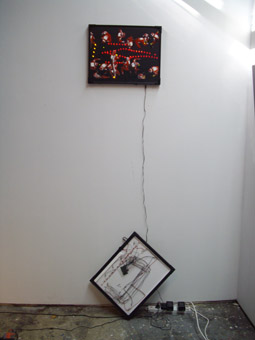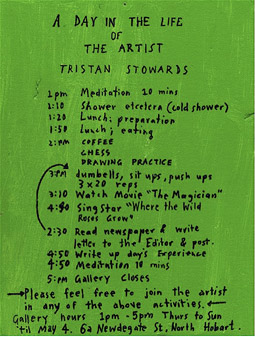art when it’s at home
lucy hawthorn frequents hobart’s gallery 6a

Scot Cotterell, Thanks For Having Us
courtesy the artist
Scot Cotterell, Thanks For Having Us
AN ECLECTIC MIXTURE OF ART OBJECTS, FOUND MATERIALS, A LIVING AREA AND AN ARTIST INHABIT HOBART’S 6A GALLERY FOR THE EXHIBITION THANKS FOR HAVING US. LOCAL ARTISTS TRISTAN STOWARDS AND SCOT COTTERELL PRODUCED WORK IN A JOINT SHOW THAT RESPONDED TO THE UNIQUELY SHAPED GALLERY SPACE. COTTERELL EXHIBITED AN ARRAY OF ARTWORKS WITH MATERIALS THAT RANGED FROM FOUND OBJECTS TO ARCHAIC VIDEO EQUIPMENT, RECONFIGURED ELECTRONICS AND PAINTED MASONITE. STOWARDS ON THE OTHER HAND TOOK THE OPPORTUNITY TO MOVE INTO THE GALLERY FOR THE DURATION OF THE EXHIBITION. THE HANDPAINTED TIMETABLE OUTSIDE THE GALLERY DOOR INVITED THE VIEWER TO EXPERIENCE “A DAY IN THE LIFE OF THE ARTIST TRISTAN STOWARDS.”
Situated in a brutally functional Besser brick building that used to house a petfood butcher’s shop, 6a Gallery is Hobart’s newest artist run-initiative. Far from the generic white cube, 6a is a relatively small, oddly shaped space, consisting of a tiny area at the entrance, a narrow hallway and a kitchenette with an unplumbed bathtub. This unconventional environment challenges artists to consider the site, and has inspired a number of diverse site-specific artworks. For Stowards, the kitchenette feature provided the perfect circumstances for his participatory artwork. Similarly the entrance to the gallery, with its roller doors and rough surrounds, complemented the aesthetics of Cotterell’s art.
Cotterell’s work sprawls across the gallery floor, a seemingly haphazard placement of objects. Powercords wind their way around a plastic-wrapped frame, dusty canvases are stacked against the wall facing away from the viewer, a large grid of ancient speakers emits distorted sound and tacky LED ‘paintings’ barely hang on the wall next to an insignificant looking bootleg copy of an ’N Sync CD. Assumedly in response to the unusual gallery space, Cotterell has shunned traditional forms of art presentation, preferring to place smaller objects on the floor or leaning against the wall so that the viewer has to bend down to engage with the works.
The artwork that initially attracts my attention is one of Cotterell’s faux ‘graffitied’ posts, which I recognise as a single part of a site-specific work in a recent outdoor sculpture trail. Out of context, the graffiti takes on a completely different meaning, emphasised by the upright post’s isolation in the forefront of the gallery. This re-presentation raises an interesting question—where do site-specific artworks go when the show is over?
I’m later informed that Cotterell’s intention is to display older exhibited work, such as the graffitied post, amongst newly produced work, in an attempt to challenge the ingrained convention of linear development in current art practice. However, the works are displayed without an artist statement, titles or dates; and for a viewer unfamiliar with Cotterell’s art practice, there is no distinguishing the old from the new. The average viewer’s only indication of the artist’s intention is the exhibition title—a rather humble “Thanks for having us.”

Tristan Stowards, Thanks For Having Us
courtesy the artist
Tristan Stowards, Thanks For Having Us
With Stowards’ artwork, the exhibition title takes on domestic connotations. Entering the artist’s temporary home, I’m surprised at the extent to which the gallery actually looks like a permanent dwelling, and I feel like an intruder in an incredibly personal space. A full bookshelf, television and bed/couch are squashed into the tiny room and the walls are crammed with Stowards’ collection of paintings, drawings and photographs.
The viewer is invited to join the artist in such diverse and often banal activities as writing letters to the editor, eating lunch and watching a movie. Stowards turns out to be a warm and enthusiastically welcoming host and I find myself returning to the gallery many times over the course of the exhibition. On my first visit, keen to avoid the “dumbell, sit ups, push ups” session, I strategically arrive in time for the 2pm “drawing practice”, after which I proudly watch as my still life, Jaffle Maker with Olive Oil Bottle against Kitchenette Tiles, is added to the growing number of drawings in the gallery hallway. My second visit is somewhat humiliating. I turn up for the 4.40pm “Singstar ‘Where the Wild Roses Grow’” and am classed a “wannabe” by the Playstation Game. Stowards’ daily timetable of tasks and play enjoyably mocks both the romantic ideal of the working artist and the dole bludger stereotype.
The creations of Stowards and Cotterell, although strikingly different in approach, offer engaging interpretations of artistic practice. Stowards achieves this by sharing his personal experience as an artist with the public in a participatory artwork, and Cotterell by his presentation of anonymous artworks which reject the contemporary art conventions of artistic progression and statements of intent. Yet, the main strength of Thanks for Having Us lies in the artists’ use of 6a, creating an entertaining exhibition that tests the function of the traditional gallery space.
Thanks For Having Us, artists Scot Cotterell, Tristan Stowards, 6a Gallery, Hobart, April 11-May 4.; 6a Newdegate Street, North Hobart is open Thursday-Sunday 1-5
RealTime issue #85 June-July 2008 pg. 54






